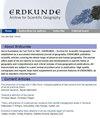Spatial analysis of hollow ways in the Hildesheimer Wald Mountains (Lower Saxony, Germany) as a model for mountainous regions of Central Europe
IF 1.1
4区 社会学
Q3 GEOGRAPHY
引用次数: 4
Abstract
The Hildesheimer Wald is a subdued mountain range situated at the northern transition from the Central German Uplands to the North German Plains. Widespread hollow way systems are distinctive anthropogeomorphic features documenting the historical importance of the region in terms of traffic and land use issues. In this manuscript we focus on the detection of hollow ways and the quantification of the surface area affected by hollow ways. Therefore, we used i) pedo-morphological field mapping in two selected areas of the central Hildesheimer Wald Mountains. These two areas were additionally surveyed using ii) a semi-automated GIS-based modelling approach to compare both mapping methodologies. The analysis of the calculated hollow-way-affected surface areas shows only minor differences (2.8 % and 0.7 %) indicating the overall high potential of this GIS-approach to map and outline hollow way systems. The pedological investigations in the two selected areas demonstrate that the soilscape is largely transformed where hollow ways frequently appear. During the development phase of hollow ways, concentrated surface runoff led to strong erosional processes at the hollow way bottoms and subsequently relatively shallow soils. In consequence, there is a remarkable loss of forestry area at degraded hollow way bottom sites, suggesting reduced usability for commercial forestry. In the second part of the study we used the GIS-mapping approach to calculate the hollowway-affected surface area for the forested area of the entire Hildesheimer Wald Mountains. We ascertained an area of 183 ha representing approximately 2.2 % of the total mountain range. Due to methodological limitations in very shallow pronounced hollow way sections it is very likely that this value is a rather conservative approximation of the real extent of hollow way systems. Since hollow ways represent preservable environmental archives storing information on cultural landscape development, we are strongly in favor of the implementation of protection measures in these specific areas. Hollow way systems should be managed adequately to avoid further degradation and additionally increase the quantity and quality of wildlife habitats.Hildesheimer Wald山脉(德国下萨克森州)空心道路的空间分析,作为中欧山区的模型
希尔德海默瓦尔德是一座地势平缓的山脉,位于从德国中部高地到德国北部平原的北部过渡地带。广泛的空心道路系统是独特的人类地貌特征,记录了该地区在交通和土地利用问题方面的历史重要性。在这份手稿中,我们专注于空心通道的检测和空心通道影响的表面积的量化。因此,我们在希尔德海默-瓦尔德山脉中部的两个选定地区使用了i)土壤形态场测绘。使用ii)基于GIS的半自动化建模方法对这两个地区进行了额外调查,以比较两种制图方法。对计算出的受空心道路影响的表面积的分析仅显示出微小的差异(2.8%和0.7%),表明这种GIS方法绘制空心道路系统地图和绘制空心道路的总体潜力很高。两个选定区域的土壤调查表明,经常出现空洞的地方,土壤景观发生了很大变化。在空心道路的发展阶段,集中的地表径流导致空心道路底部和随后相对较浅的土壤发生强烈的侵蚀过程。因此,退化的空心路底部场地的林业面积显著减少,这表明商业林业的可用性降低。在研究的第二部分中,我们使用GIS制图方法计算了整个希尔德海默-瓦尔德山脉森林地区受空洞影响的表面积。我们确定了183公顷的面积,约占整个山脉的2.2%。由于非常浅的明显空心路段的方法限制,该值很可能是空心系统实际范围的一个相当保守的近似值。由于空心通道代表了保存文化景观发展信息的可保存环境档案,我们强烈赞成在这些特定区域实施保护措施。应充分管理空心系统,以避免进一步退化,并增加野生动物栖息地的数量和质量。
本文章由计算机程序翻译,如有差异,请以英文原文为准。
求助全文
约1分钟内获得全文
求助全文
来源期刊

Erdkunde
地学-自然地理
CiteScore
2.00
自引率
7.10%
发文量
17
审稿时长
>12 weeks
期刊介绍:
Since foundation by Carl Troll in 1947, ''ERDKUNDE – Archive for Scientific Geography'' has established as a successful international journal of geography. ERDKUNDE publishes scientific articles covering the whole range of physical and human geography. The journal offers state of the art reports on recent trends and developments in specific fields of geography and comprehensive and critical reviews of new geographical publications. All manuscripts are subject to a peer-review procedure prior to publication. High quality cartography and regular large sized supplements are prominent features of ERDKUNDE, as well as standard coloured figures.
 求助内容:
求助内容: 应助结果提醒方式:
应助结果提醒方式:


